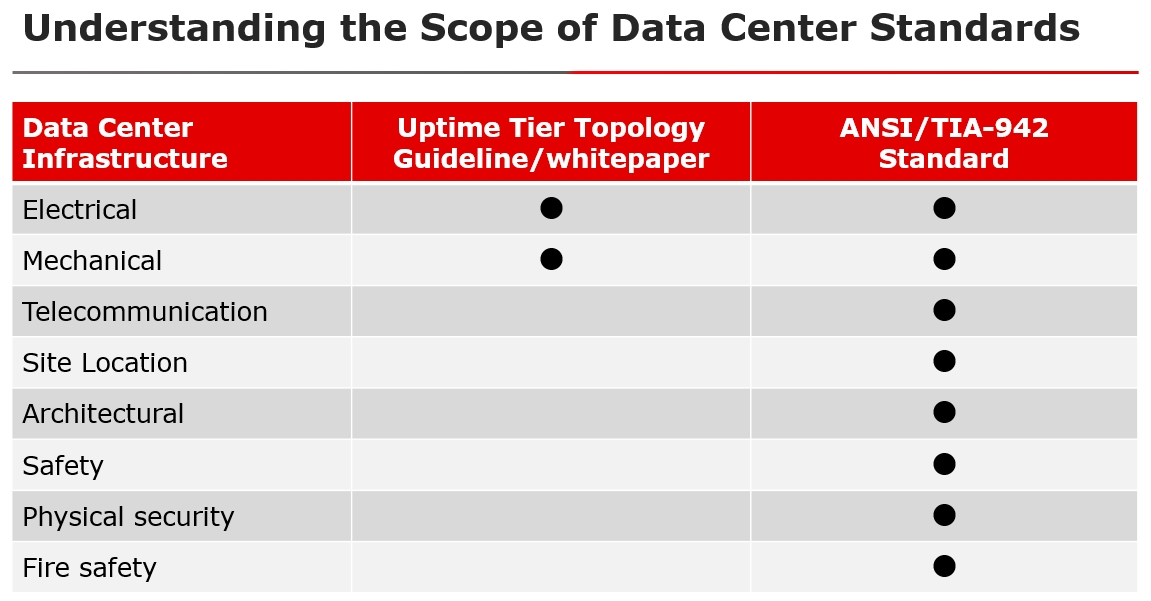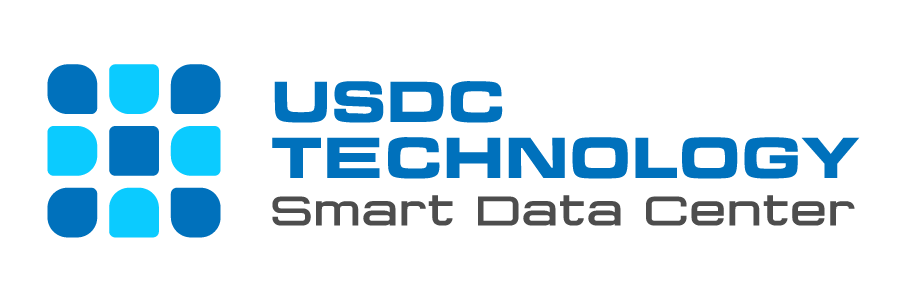When it comes to building and maintaining data centers, reliability, security, and efficiency are paramount. Two prominent standards in this field are the Uptime Institute’s Tier Standard Topology (UTI:TST) and the ANSI/TIA-942 Telecommunications Infrastructure Standard. Understanding the scope and implications of these standards is crucial for data center designers, operators, and owners. This blog will explore the key differences between UTI:TST and ANSI/TIA-942, and why a comprehensive approach to data center certification matters.
The Uptime Institute’s Tier Standard Topology (UTI:TST)
– Core Areas: UTI:TST focuses on the electrical and mechanical infrastructure of data centers.
– Assessment: It evaluates power systems, cooling mechanisms, and their redundancies to classify data centers into Tiers I through IV, with Tier IV being the highest level of redundancy and reliability.
– Key Limitation: The narrow scope means that critical aspects such as physical security, site location, fire suppression, and overall building infrastructure are not evaluated.
Criticism: A notable criticism of UTI:TST is its limited scope. A data center could technically achieve a Tier IV rating based solely on its power and cooling systems, even if other critical aspects are deficient. This limitation raises concerns about the overall reliability and safety of data centers certified under this standard.
The ANSI/TIA-942 Telecommunications Infrastructure Standard
– Comprehensive Coverage: ANSI/TIA-942 provides a holistic approach to data center certification, covering telecommunications, electrical and mechanical systems, physical security, safety, and site location.
– Annexes: The standard includes several informative annexes that provide detailed guidelines on various aspects of data center design and operation.
– Intent: Despite the annexes being labeled as ‘informative,’ the standard’s introduction and references throughout indicate a comprehensive approach to data center design, ensuring all critical infrastructure aspects are covered.
Key Elements
– Facility Planning: Encompasses the design and layout of the data center.
– Cabling System: Details the telecommunications infrastructure.
– Network Design: Ensures robust network architecture.
– Failsafe Systems: Includes power, environmental controls, and fire suppression.
– Resiliency Ratings: Defines four levels of resiliency related to the data center’s infrastructure.

Practical Implications
Real-World Application
– UTI:TST: Seen as easier to achieve due to its limited scope. However, this can result in significant oversight of other critical areas, posing potential risks to the overall reliability and security of the data center.
– ANSI/TIA-942: Considered comprehensive but more complex. Data center operators and owners typically use the full content of the standard, including its annexes, to ensure a reliable, secure, and efficient data center.
Addressing Common Misconceptions
Misconception 1: UTI:TST’s Limited Scope Means Easier Certification
Reality: While the smaller scope might seem simpler, UTI:TST’s stringent requirements (e.g., prime generators, strict ambient conditions) can be more challenging and costly to meet.
Misconception 2: ANSI/TIA-942 is Too Prescriptive
Reality: The standard provides detailed guidelines but allows flexibility in achieving the overall goals. It supports a balanced approach to certification, focusing on meeting overarching requirements rather than rigidly adhering to every detail.
Misconception 3: Failing to Meet ANSI/TIA-942 Requirements Means No Certification
Reality: Certification allows for Category 1 (Cat-1) and Category 2 (Cat-2) non-conformities. Non-critical non-conformities (Cat-2) do not automatically disqualify a data center from certification.
Topic Summary
UTI:TST
– Strength: Provides a rigorous assessment of electrical and mechanical systems.
– Weakness: Limited scope can lead to critical oversight in other essential areas of data center infrastructure.
ANSI/TIA-942
– Strength: Offers a comprehensive assessment covering all critical aspects of a data center.
– Weakness: Perceived complexity due to its extensive requirements, though this is mitigated by a flexible approach to meeting overarching goals.
While UTI:TST might appear easier due to its narrow focus, it can leave significant gaps in the overall assessment of a data center’s reliability and security. ANSI/TIA-942, despite its complexity, provides a more holistic and robust framework, ensuring all critical infrastructure aspects are adequately addressed. For data center designers, operators, and owners, the choice between these standards should be informed by a thorough understanding of their scope and implications, ensuring the highest standards of reliability and security for their facilities.
Media Contact
Universal Smart Data Center Technology
Phone: (+84) 28 73080708
Email: info@usdc.vn


